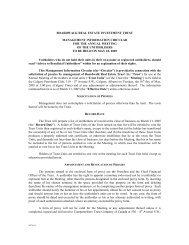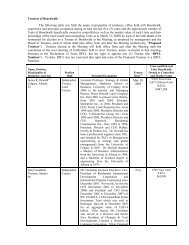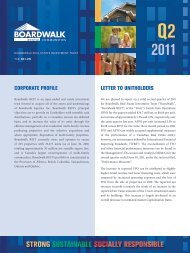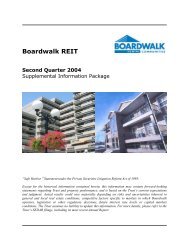BMO Financial Group - Outlook 2005(1.1Mb pdf File) - Boardwalk REIT
BMO Financial Group - Outlook 2005(1.1Mb pdf File) - Boardwalk REIT
BMO Financial Group - Outlook 2005(1.1Mb pdf File) - Boardwalk REIT
Create successful ePaper yourself
Turn your PDF publications into a flip-book with our unique Google optimized e-Paper software.
30<br />
Oil Price <strong>Outlook</strong><br />
Supply risk roils oil prices<br />
Oil prices have spiked above the US$50/barrel<br />
mark for US benchmark West Texas<br />
Intermediate (WTI). In current dollar terms, this<br />
is higher than they have ever been.<br />
High oil prices partially reflect rapid growth in<br />
global consumption, particularly in China and<br />
other parts of Asia. Despite a number of<br />
disruptions to supply this year, global<br />
production of oil has more than kept pace with<br />
demand, allowing for a rebuild of inventories<br />
from very low levels at the beginning of the<br />
year. Strong supply growth primarily reflects<br />
continued robust gains in Russia and a<br />
substantial ramping up of production by OPEC.<br />
However, in order to quickly raise output,<br />
OPEC has had to reduce its margin of excess<br />
capacity. This narrowing of OPEC’s cushion to<br />
deal with supply shocks – at a time when<br />
geopolitical and weather-related events have<br />
made such a cushion so important – has<br />
unsettled the global oil market and contributed<br />
to the large risk premium on prices. Thus,<br />
while production is currently adequate to meet<br />
demand and rebuild inventories, high oil prices<br />
reflect the market’s concern about geopolitical<br />
risks to available supply and OPEC’s narrow<br />
margin to deal with risks that actually<br />
materialize.<br />
Looking ahead, some elements of supply risk<br />
are likely to diminish during the next year.<br />
Some have already fallen off the radar screen<br />
and others are likely to follow. Further, markets<br />
do respond to high prices. Both supply and<br />
consumption adjust to changing prices,<br />
although in the oil market this sometimes takes<br />
quite a while. Nevertheless, high prices are<br />
stimulating investment in new oil producing<br />
capacity in OPEC and elsewhere. And, if<br />
sustained, high prices would lead households<br />
and businesses to take steps to reduce<br />
consumption of oil-based products. Newly<br />
emerging risks, such as the possibility of labour<br />
strikes and increasing rebel insurgency in<br />
Nigeria, could push prices even higher during<br />
the next few months, particularly with the<br />
approach of the winter heating season.<br />
However, over the medium- to longer-term, oil<br />
prices are not likely to be sustained at current<br />
levels.<br />
This note examines current oil market<br />
conditions in an historical context and<br />
assesses the likely direction of factors which<br />
have forced prices well above normal.<br />
Oil prices spike well above normal range<br />
Oil prices are at record-high levels in terms of<br />
current dollars. However, adjusted for inflation,<br />
they are well below those prevailing in 1980,<br />
following the revolution in Iran. For instance,<br />
using constant 2004 dollars, oil prices in early<br />
1980 were over US$80/barrel. However,<br />
adjustments on both the demand and supply<br />
sides of the market during the ensuing few<br />
years led to a sharp reduction in oil prices. By<br />
1986, the West Texas Intermediate price fell<br />
back into its ‘normal’ range.<br />
In assessing the equilibrium price for oil and a<br />
normal trading range around that price, oil<br />
markets for 1986-2003 interval were examined.<br />
During that period, the real price of WTI, in<br />
constant 2004 dollars, averaged US$25/barrel.<br />
Its ‘normal’ range, as measured by two<br />
standard deviations on either side of the<br />
average, was US$15-35/barrel during that<br />
period. There have been a few times when<br />
prices moved outside that normal range. At the<br />
time of the first Gulf War at the beginning of the<br />
1990s, oil prices temporarily spiked above<br />
US$40/barrel (in constant 2004 dollars). In<br />
1998, following an up-shift in OPEC production,<br />
which just preceded the economic and financial<br />
crisis in Asia, oil prices fell to around US$10/<br />
barrel. And, currently, they are well above their<br />
normal range and are likely to stay above<br />
longer than they did in the early 1990s.
















